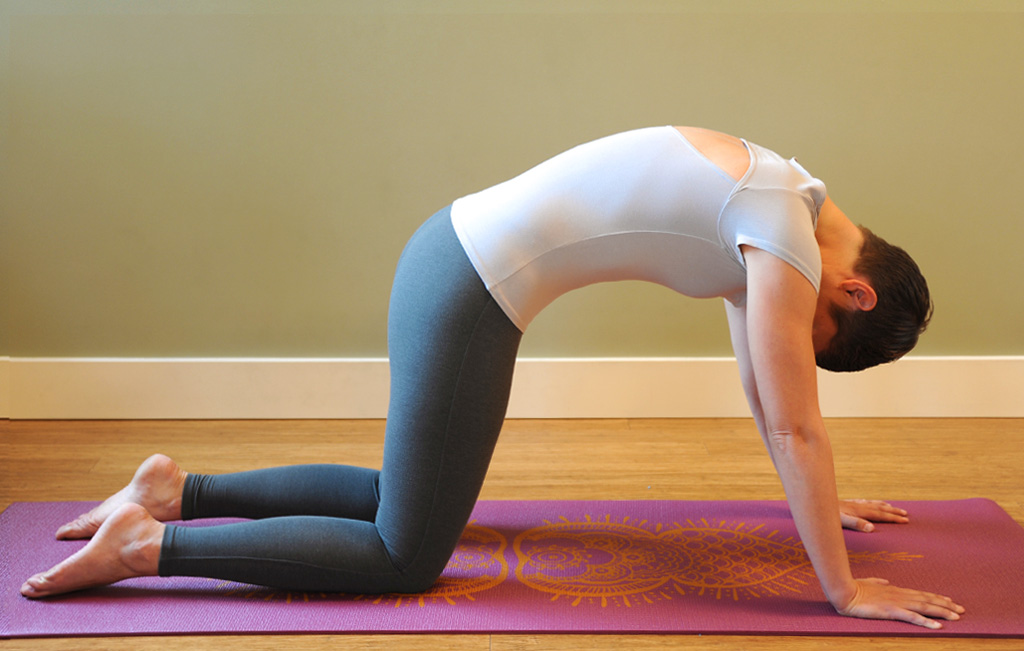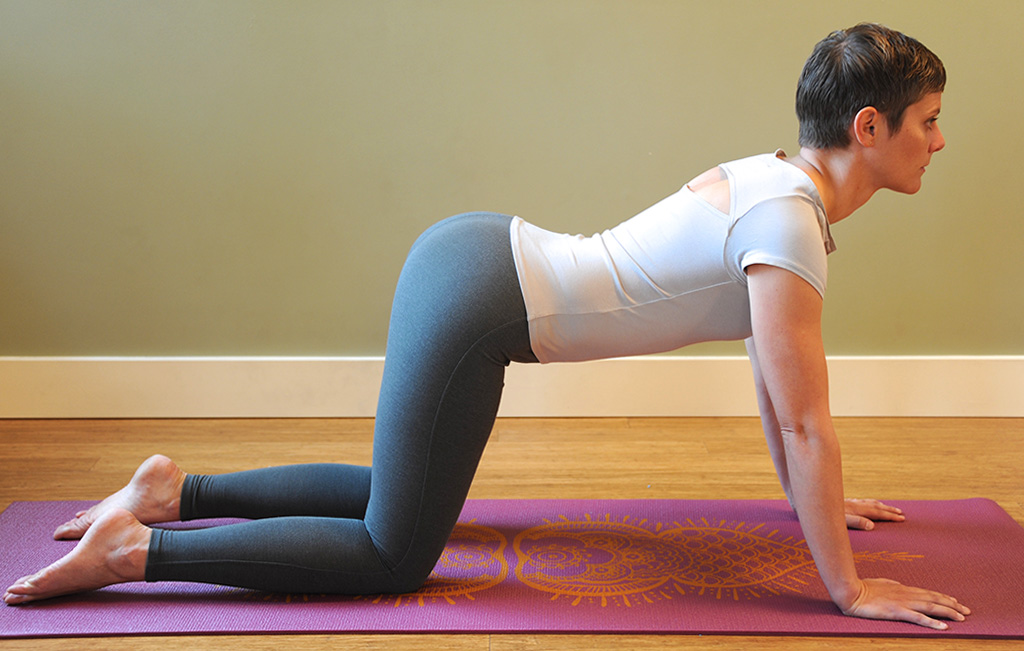
Marjarasana (Cat Pose)
Every morning as I begin to stir, the three felines that share my sleeping hours begin to mobilize along with me. The promise of breakfast, of course, is the great motivator, but before breakfast—before they do anything else—they do a little cat yoga.
They begin with Downward Facing Cat. As their front paws stretch forward, I watch as the stretch ripples its way up to the pinnacle of their bodies: their hips. Then they return to all fours, and I watch their furry skin elongate and vibrate as they stretch each foreleg forward and each hind leg back. Often they arch their spines upward, reminiscent of a Halloween cat—minus the hissing.
From my human perspective, cat yoga (or dog yoga if you have canine companions) looks exquisitely natural and elemental. Cats stretch because it feels good, not because they’re hoping to accomplish a pose. There’s an authenticity to cat yoga that generates and internal “aaahhh” for me even as a spectator.
How Stretching Breaks Up the “Fuzz”
Why do dogs and cats always stretch upon arising? And why do many humans indulge in a horizontal bed stretch before we move toward vertical? Anatomist Gil Hedley says the stretching instinct is related to microscopic “fuzz” that forms over our muscles when we spend long periods immobile. This fuzz is actually an incipient form of loose connective tissue called fascia that covers muscle surfaces. Hedley posits that when we are immobile for long periods of time, the fuzz can start to thicken and form adhesions. We move and stretch to break up the formation of adhesions in the fuzz, so that the fascia can remain fluid and flexible, allowing our muscle surfaces to slide easily over one another. (You can watch Hedley’s short video, “The Fuzz Speech,” here.)
This is why I instinctually begin my own yoga practice with slow, exploratory, fuzz-busting movements. I use Marjarasana-Bitilasana (Cat-Cow Pose) as the basis for warming up my spine and joints for the rest of my asana practice. Marjarasana flexes (forward bends) the spine and Bitilasana extends (back bends) the spine.
Marjarasana-Bitilasana wakes up the large postural muscles of the back and front bodies. However, the spine is also capable of rotating and moving laterally. These movements wake up the smaller spinal muscles. For me, just bending forward and back doesn’t feel complete, so I add lateral and rotational movements to my Cat-Cow stretches as well.

Bitilasana (Cow Pose)
How to Practice Marjarasana-Bitilasana
- Begin on all fours on a yoga mat with your hands directly beneath your shoulders and knees directly beneath your hips. You may want to add a folded yoga blanket as extra padding for your knees.
- Take a moment to relax onto all fours, aware of how the weight is distributed across your hands and knees. Spread the palms of your hands and lengthen through your fingers.
- On an exhalation, slowly drop the tip of your tailbone down allowing your pelvic rim to tilt back and your spine to round upward.
- Let the movement sequence up the back so that you initiate with your tailbone, letting your head respond last.
- Take a few deep breaths at your full forward bend to feel the elongation of your back body. This is Marjarasana.
- On an inhalation, slowly lift the tip of your tailbone so that your pelvic rim begins to tip forward and you feel your lower spine dipping into your back.
- Again, allow this movement to sequence up the spine so that your head is the last thing to lift. Do not overarch your head back. Instead, look straight head.
- Take a few deep breaths here to feel the elongation of your front body. This is Bitilasana.
- Move back and forth, between forward and back bending several times, keeping all your joints soft and fluid, and matching the movements to your breathing. Make sure you keep the movement incremental, i.e., begin each movement at your tailbone and let the movement sequence up your spine so that your head responds last.
Marjarsana-Bitilasana Variations
Try this lateral bending variation:
- After practicing a few rounds of Marjarasana-Bitiliasana, return to a neutral hands-and-knees position for a few breaths.
- Inhale, then on an exhalation, turn your shoulders and hips to the right, toward one another, so that your entire left torso lengthens.
- Inhale, turning back to the center and then, on an exhalation, curl to the left, feeling your right torso elongate.
- Repeat this movement several times, breathing continuously. Again let your joints be soft, relaxed and fluid.
Then try this spinal rotation variation:
- Return to the center and stretch your left leg back behind you. Grounding your left hand, turn your torso to the right and raise your right hand up toward the ceiling.
- Widen your chest and upper back as you elongate your left leg back.
- After a few breaths, return to the center and repeat on the other side.
These simple stretches free the spine to move in all its possible directions out of its central axis. They also break up the accumulation of fuzz that can inhibit spinal movement. In a sense, the gentle, fluid movements of Marjarasana-Bitilasana and its variations cleanse the fascia of potentially adhesive fuzz build-up.
Cats and dogs know this intuitively. For humans, practicing Marjarasana-Bitilasana with mindfulness and the spirit of investigation, can make our first morning stirrings—or our yoga practice—just as divinely satisfying as those of our feline and canine friends.

As a half-cat, half-person, I can attest to the fuzz-busting value of slow stretching, which I do with my half-cat, half-person friend, Irving, but I don’t know about this half-cow business—-is it moo or meow?
Well, as an ailurophile, I like to emphasize the cat portion of this stretch and my feline friends model both the cat and cow portions daily. Since cows have traditionally been considered sacred in India, it seems a positive pairing.
Ailurophile! Now, that’s a great word! Half of me LOVES of it, while the other half of me BASKS in the love. Thank you for stretching my mind as well as my cat/human body.